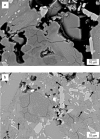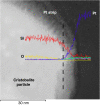The structure of volcanic cristobalite in relation to its toxicity; relevance for the variable crystalline silica hazard
- PMID: 23164071
- PMCID: PMC3574026
- DOI: 10.1186/1743-8977-9-44
The structure of volcanic cristobalite in relation to its toxicity; relevance for the variable crystalline silica hazard
Abstract
Background: Respirable crystalline silica (RCS) continues to pose a risk to human health worldwide. Its variable toxicity depends on inherent characteristics and external factors which influence surface chemistry. Significant population exposure to RCS occurs during volcanic eruptions, where ashfall may cover hundreds of square km and exposure may last years. Occupational exposure also occurs through mining of volcanic deposits. The primary source of RCS from volcanoes is through collapse and fragmentation of lava domes within which cristobalite is mass produced. After 30 years of research, it is still not clear if volcanic ash is a chronic respiratory health hazard. Toxicological assays have shown that cristobalite-rich ash is less toxic than expected. We investigate the reasons for this by determining the physicochemical/structural characteristics which may modify the pathogenicity of volcanic RCS. Four theories are considered: 1) the reactivity of particle surfaces is reduced due to co-substitutions of Al and Na for Si in the cristobalite structure; 2) particles consist of aggregates of cristobalite and other phases, restricting the surface area of cristobalite available for reactions in the lung; 3) the cristobalite surface is occluded by an annealed rim; 4) dissolution of other volcanic particles affects the surfaces of RCS in the lung.
Methods: The composition of volcanic cristobalite crystals was quantified by electron microprobe and differences in composition assessed by Welch's two sample t-test. Sections of dome-rock and ash particles were imaged by scanning and transmission electron microscopy, and elemental compositions of rims determined by energy dispersive X-ray spectroscopy.
Results: Volcanic cristobalite contains up to 4 wt. % combined Al(2)O(3) and Na(2)O. Most cristobalite-bearing ash particles contain adhered materials such as feldspar and glass. No annealed rims were observed.
Conclusions: The composition of volcanic cristobalite particles gives insight into previously-unconsidered inherent characteristics of silica mineralogy which may affect toxicity. The structural features identified may also influence the hazard of other environmentally and occupationally produced silica dusts. Current exposure regulations do not take into account the characteristics that might render the silica surface less harmful. Further research would facilitate refinement of the existing simple, mass-based silica standard by taking into account composition, allowing higher standards to be set in industries where the silica surface is modified.
Figures




References
-
- International Agency for Research on Cancer. Silica, some silicates, coal dust and para-aramid fibrils. International Agency for Research on Cancer, Lyon; 1997. - PubMed
-
- Health and Safety Executive. Respirable crystalline silica - phase 1. Variability in fibrogenic potency and exposure-response relationships for silicosis. Health and Safety Executive, Sudbury; 2002.
-
- Haklader ACD, Roberts AL. Transformation of quartz to cristobalite. J Am Ceram Soc. 1961;44:35–41. doi: 10.1111/j.1151-2916.1961.tb15344.x. - DOI
-
- Ghiazza M, Gazzano E, Bonelli B, Fenoglio I, Polimeni M, Ghigo D, Garrone E, Fubini B. Formation of a vitreous phase at the surface of some commercial diatomaceous earth prevents the onset of oxidative stress effects. Chem Res Toxicol. 2008;22:136–145. - PubMed
Publication types
MeSH terms
Substances
LinkOut - more resources
Full Text Sources
Medical
Research Materials
Miscellaneous

